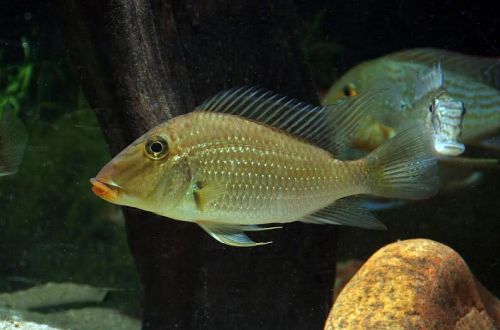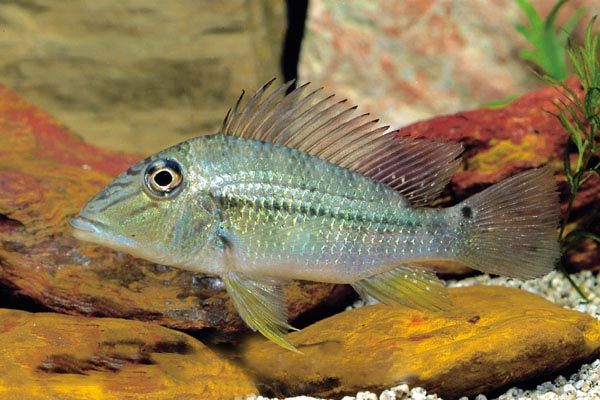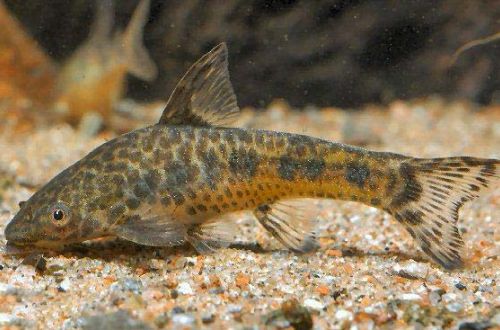
Geofaus Yurupara
Yurupari or Geofaus Yurupara, scientific name Satanoperca jurupari, belongs to the Cichlidae family. The translation from Latin sounds menacing – “demon fish”, and the word Yurupari itself is used by the indigenous peoples of South America to refer to an evil forest spirit. Such legends are more likely connected not with the habits of this fish, it is rather peaceful, but with its behavior in nature, where it often hides at the bottom, burrowing its head in the debris from fallen leaves.
Difficult to keep fish due to high requirements for water quality and a special way of feeding, therefore, it cannot be recommended for beginner aquarists.

Contents
Habitat
It comes from South America from the vast Amazon basin, where it is found everywhere along the entire course. It prefers small tributaries, floodplain lakes with soft substrates, littered with leaves and other plant debris (branches, tree roots, etc.), in which fish often hides, burrowing with their whole body.
Brief information:
- The volume of the aquarium – from 500 liters.
- Temperature – 20-28°C
- Value pH — 5.5–7.5
- Water hardness – 2–12 dGH
- Substrate type – sandy
- Lighting – subdued
- Brackish water – no
- Water movement is weak
- The size of the fish is 15–18 cm.
- Food – small sinking food from a variety of products
- Temperament – peaceful
- Keeping in a group of 5-8 individuals
Description

Adult males reach a length of about 18 cm. Females are somewhat smaller – 15 cm. Otherwise, there are no visible differences between the sexes. The color is uniform, depending on the lighting it may appear silvery or beige. The large head is decorated with a barely noticeable ornament of dark lines, and at the base of the tail (in the upper part) there is a black dot.
Food
In nature, they feed near the bottom, picking up a portion of the soil in their mouths and sifting it through the gills in search of zoo- and phytoplankton. In the home aquarium, it is necessary to offer sinking foods that combine various foods with herbal supplements. For example, dry flakes and granules with frozen brine shrimp, daphnia, bloodworm pieces, etc. Food fragments should be small.
Maintenance and care, arrangement of the aquarium
The optimal size of the aquarium for a group of 5-8 fish starts from 500 liters or more. The design is simple, consists of snags and sandy soil. Due to the special way of feeding Geofaus Yurupara, rooted plants are unlikely to take root. The lighting is subdued. Plants floating on the surface will serve as an additional means of shading. Particular attention should be paid to the ground, it should consist of sand and / or tiny pebbles. Any large stones, if they enter the fish’s mouth, can get stuck in it.
In its natural habitat, the bottom of the reservoirs is covered with fallen leaves. In the aquarium, they will also come in handy, but it is recommended to use them in small quantities so that there are large free areas of open ground at the bottom. The leaves serve not so much as an element of decoration, but rather give the water a characteristic chemical composition, saturating it with tannins in the process of decomposition. Read more in the article “Which tree leaves can be used in an aquarium.”
The key to maintaining Uprurari is to ensure high water quality (free of contaminants) and keep it within the acceptable range of hydrochemical values. For this purpose, regular aquarium maintenance procedures are carried out. At a minimum, part of the water should be replaced weekly with fresh water (50–70% of the volume) and uneaten food and excrement should be removed in a timely manner.
A large load falls on the filtration system. It must purify a large volume of water, as well as resist the constant clogging of sand, which constantly rises in a small cloud during the feeding of fish. Usually combined external filters are used. First – a simple mechanical filter takes water from the aquarium and pumps it into the sump, without passing the sand. From the sump, water enters the main (second) filter, which performs other types of purification, and is pumped back into the aquarium.
Behavior and Compatibility
Peaceful calm fish, if it is in a group of 5-8 individuals. In smaller amounts, nervous behavior is possible. The alpha male sometimes shows signs of aggression towards weaker relatives. The latter especially often happens when there is not enough space. Calmly refers to other species of comparable size. Fish that are too small may be accidentally preyed upon.
Breeding / breeding
In favorable conditions, spawning is quite frequent. With the onset of the mating season, the alpha male chooses a suitable female for himself, and after a short courtship, they separate from the group and occupy a small area at the bottom of the aquarium. Their temporary territory is usually concentrated near a piece of driftwood or any other hard object. A couple of days before spawning, the couple begins to defend their territory, driving other fish out of it.
The female lays eggs in batches of several and waits for the male to fertilize them. The process is repeated several times until the clutch grows to hundreds of eggs. At the end of spawning, the female swims away, leaving the clutch in the care of the male, who will continue to protect her offspring for several days after the fry appear.
Fish diseases
The main cause of diseases lies in the conditions of detention, if they go beyond the permissible range, then immunity suppression inevitably occurs and the fish becomes susceptible to various infections that are inevitably present in the environment. If the first suspicions arise that the fish is sick, the first step is to check the water parameters and the presence of dangerous concentrations of nitrogen cycle products. Restoration of normal/suitable conditions often promotes healing. However, in some cases, medical treatment is indispensable. Read more about symptoms and treatments in the Aquarium Fish Diseases section.





